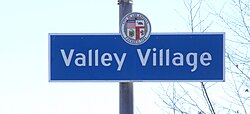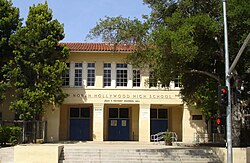Climate
Located within the San Fernando Valley, Valley Village has a higher degree of diurnal temperature variation than the nearby basin or coastal areas. According to the Köppen climate classification system, Valley Village has a hot-summer Mediterranean climate (Csa), with subtropical and semi-arid characteristics. Summers are long, hot, dry and smoggy, with average high temperatures in the mid-80s to lower-90s °F (30–34 °C), with nighttime lows in the upper-50s to lower-60s °F (14–17 °C). Temperatures reach or surpass 100 °F (38 °C) several times during the summer, raising the risk of heat stroke or other heat-related illnesses. The all-time record high temperature in Valley Village is 117 °F (47 °C), recorded on September 6, 2020.
Winters are short, sunny and typically warm, with average high temperatures in the upper-60s to lower-70s °F (20–23 °C), but with chilly nights in the lower-to-mid 40s °F (4–7 °C). Winter is also the wet season, but rain is usually infrequent, even during the winter months, as most of the area's rain comes from Pacific storms. It can be especially rainy during El Niño cycles, with flash flooding sometimes occurring. Sub-freezing temperatures (32 °F, 0 °C) and below, as well as frosts, occur several times during the winter; however, these cold weather events are typically brief, usually only lasting for a day or two before temperatures return to normal. Snow is extremely rare. The all-time record low temperature in Valley Village is 23 °F (–5 °C), recorded on January 29, 1979.
Spring and fall hardly exist in this climate, with these months typically being sunny and warm. The Santa Ana winds typically occur between fall and spring, lowering humidity levels and raising temperatures, which increases the risk for wildfires. During the late spring and early summer, more specifically in the months of May and June, conditions are often overcast and foggy, a phenomenon known by local residents as "May Gray" or "June Gloom".
| Climate data for Valley Village, Los Angeles |
|---|
| Month | Jan | Feb | Mar | Apr | May | Jun | Jul | Aug | Sep | Oct | Nov | Dec | Year |
|---|
| Record high °F (°C) | 92
(33) | 92
(33) | 98
(37) | 103
(39) | 105
(41) | 114
(46) | 115
(46) | 112
(44) | 117
(47) | 106
(41) | 97
(36) | 93
(34) | 117
(47) |
|---|
| Mean daily maximum °F (°C) | 67.4
(19.7) | 68.1
(20.1) | 71.0
(21.7) | 74.5
(23.6) | 78.7
(25.9) | 84.0
(28.9) | 90.3
(32.4) | 91.9
(33.3) | 88.7
(31.5) | 81.2
(27.3) | 73.6
(23.1) | 67.1
(19.5) | 78.0
(25.6) |
|---|
| Mean daily minimum °F (°C) | 42.1
(5.6) | 43.4
(6.3) | 45.6
(7.6) | 48.6
(9.2) | 53.3
(11.8) | 57.0
(13.9) | 61.0
(16.1) | 61.2
(16.2) | 59.1
(15.1) | 52.8
(11.6) | 45.6
(7.6) | 41.2
(5.1) | 50.9
(10.5) |
|---|
| Record low °F (°C) | 23
(−5) | 26
(−3) | 28
(−2) | 30
(−1) | 32
(0) | 36
(2) | 40
(4) | 41
(5) | 39
(4) | 31
(−1) | 28
(−2) | 26
(−3) | 23
(−5) |
|---|
| Average precipitation inches (mm) | 3.94
(100) | 4.32
(110) | 3.51
(89) | 0.84
(21) | 0.27
(6.9) | 0.06
(1.5) | 0.01
(0.25) | 0.17
(4.3) | 0.25
(6.4) | 0.50
(13) | 1.19
(30) | 2.05
(52) | 17.12
(435) |
|---|
| Source 1: [13] |
| Source 2: [14] |







